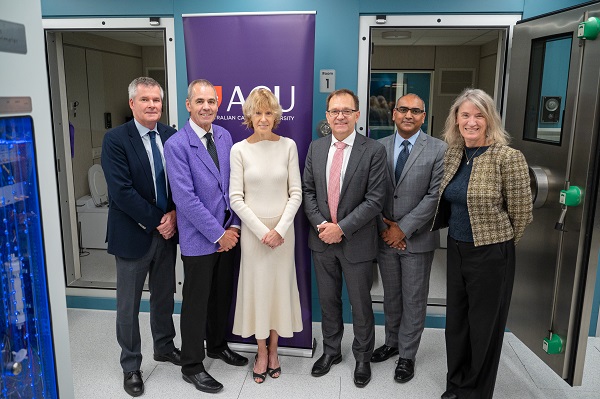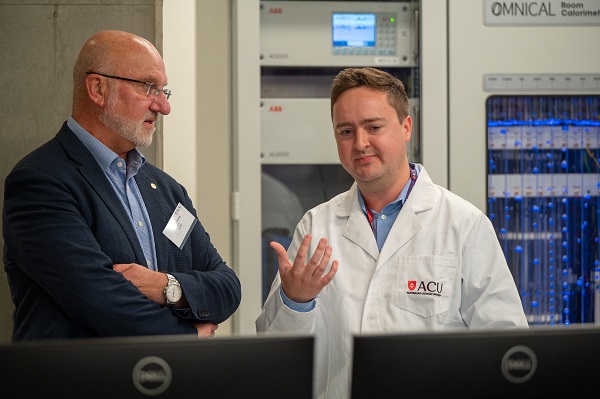Our $5 million state-of-the-art human metabolic chamber – the only one of its kind in the southern hemisphere – has officially opened at the Melbourne campus.
The new facility within ACU's health precinct reinforces the university's position at the forefront of global research into metabolic health, exercise, and diet.
Designed and built by the world-leading team from Maastricht Instruments in the Netherlands, it will revolutionise metabolic disorders research, ranging from obesity and type 2 diabetes to diseases underpinned by rare metabolic conditions.
The two-room chamber allows researchers to perform resting metabolic rate measurements, take blood and other tissue samples, and monitor a person overnight or over several days to study their metabolism, sleep patterns, and other health-related outcomes.

At the official opening, ACU Vice-Chancellor and President Professor Zlatko Skrbis said the facility's sophisticated technology will strengthen the university's research capacity and unlock new avenues of research for academic, industry and government partners to become a catalyst for innovation and discovery.
"We celebrate not only the physical infrastructure of ACU's health precinct but also the intellectual capital it represents—the brilliant minds, the relentless curiosity, and the unwavering dedication to advancing knowledge for the betterment of society within a thriving ecosystem of partners," Professor Skrbis said.
"The establishment of the human metabolic chamber facility within this precinct signifies our commitment to fostering collaboration and translating research into tangible outcomes for people living with life-threatening conditions."
The driving force behind the development of the chamber and director of the Mary MacKillop Institute for Health Research, Professor John Hawley, said the facility will boost ACU's research capacity in many areas including the study of obesity, type 2 diabetes, sleep, circadian biology, and sports nutrition.
"Obesity and type 2 diabetes are two metabolic risk factors that lead to cardiovascular disease and premature deaths, so new approaches are needed to capture the dynamics of acute and chronic interventions which are important for changes to lifestyle or habitual behaviour," Professor Hawley said.
As the effects of our 21st century "round-the-clock" lifestyle are directly linked to a rise in many metabolic conditions, Professor Hawley said nuanced research on the relationship between sleep and circadian biology was crucial.

How it works
Metabolic chambers are airtight rooms which monitor energy expenditure while awake, sleeping, and exercising as well as assessing the thermic effect of food on metabolism.
Participants stay in the room overnight or up to several days, enabling researchers to quantify and measure many aspects of human metabolism in response to exercise, diet or pharmacological interventions.
The room is fitted with a low-draft air conditioning system with temperature and humidity control and can also be equipped with exercise ergometers. The chamber can also be dialled up to mimic living at altitude.
Fresh air is circulated into the room and calibrated analysers measure the ratio of expired carbon dioxide and oxygen in real-time allowing researchers to determine the contribution of fats and carbohydrate to overall energy metabolism while in the chamber.
"Having participants stay either overnight or longer in a closed environment enables researchers to capture minute-by-minute metabolism in response to a specified intervention, such as different diets, or exercise protocols," Professor Hawley said.
"There are many big scientific questions that can be tackled and facilitated in the new human metabolic chamber."
He said the chamber has wide reaching implications for both individuals in the community to athletes.

Key features include:
- Two fully equipped rooms for short-term (overnight) or extended stays
- Extensive physiological and environmental data acquisition system delivering traceable raw data and calculated parameters
- Advanced environment control system for temperature and humidity
- Sampling interfaces for blood, urine, faeces
- Environmental control (hypoxia, lighting), different room configurations, or additional physiological measurements (physical activity, ECG, heart rate, respiration rate, body temperature, skin temperature, blood pressure, blood glucose).

ACU's Deputy Vice-Chancellor Research and Enterprise Professor Abid Khan said the new facility added another dimension to the nation's capability in medical research.
"With the surrounding ecosystem of people and capabilities it establishes a truly unique platform for researchers exploring solutions to some of the most pressing health challenges of our time," Professor Khan said.
"This extraordinary research facility embodies our commitment not only to advancing the frontiers of metabolic research but also to translating the implications on health and disease to the public good."
ACU's Vision 2033 Strategy sees the university embrace a sustainable and integrated research, education, and engagement model to tackle issues of national and commercial significance. The complementary ACU Research and Enterprise Plan will address strategic areas of community need, particularly issues facing the care economy.
The human metabolic chamber is the result of 35 years of world-leading metabolic research from the Metabolic Research Unit Maastricht (MRUM) in the Netherlands. Watch more here.







